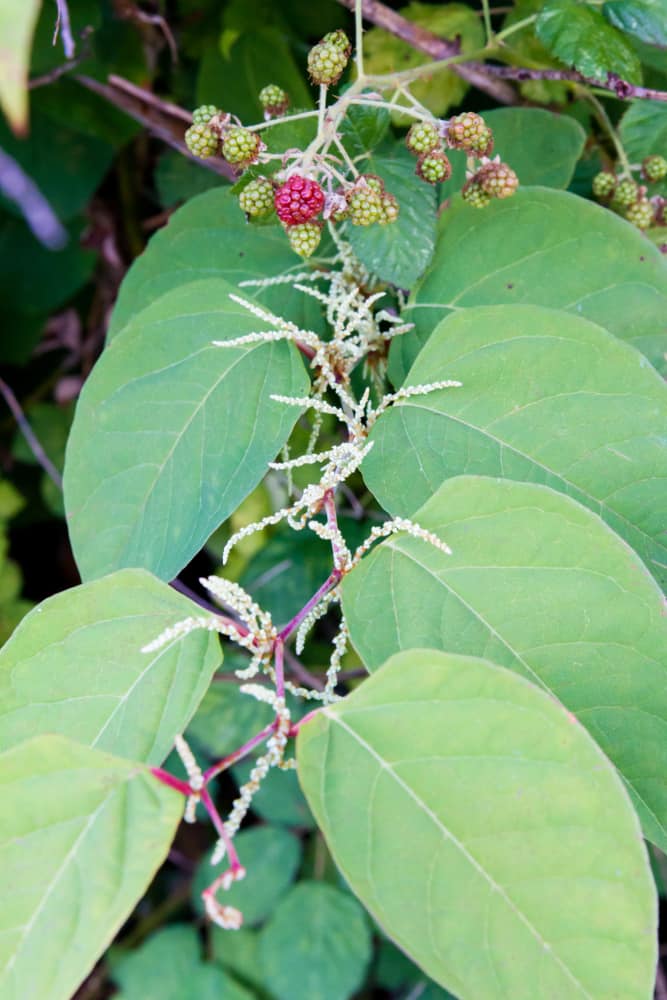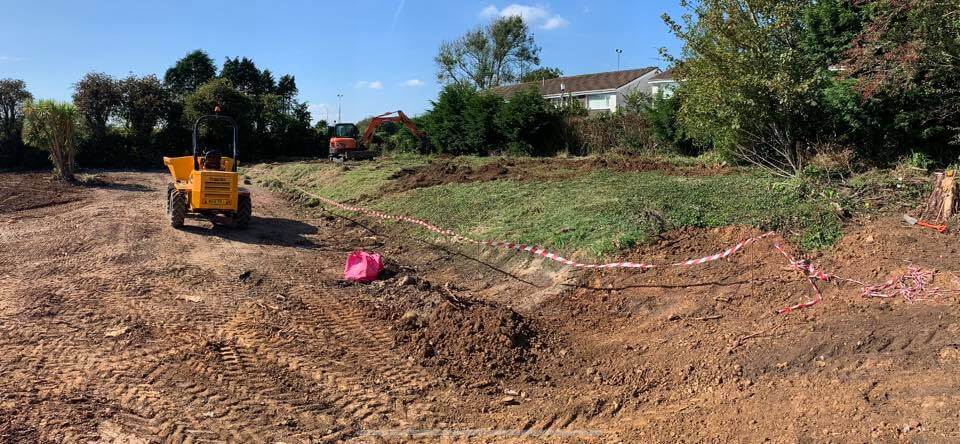Commercial Knotweed Removal discussed by Green Leaf Remediation
When it comes to Japanese Knotweed you should always use a professional Knotweed specialist who has the experience to identify and offer suitable solutions for your Commercial Knotweed Removal. Knotweed is a perennial weed which is often also referred to as Fallopia Japonica, Bamboo and Peashooters. It was brought to the UK in around 1854 and has a huge propensity to spread if its not treated properly by an expert. Its ability to spread quickly is due to the fact that it was introduced to the UK without the insect (‘psyllid’) which keeps its growth under control. The crown and rhizomes (root system) of knotweed suppress other plants growing around it and it spreads extensively and quickly underground. Established shoots can grow more than 3 metres high and it will colonize the soil within a few years. In the height of its predominant growing season, 60% of its roots are in the soil underground making removal extremely difficult and being true to its reputation of being known as one of the UK’s most invasive non-native plants.
It has quickly become one of the most invasive weeds present in the UK and there are millions of homeowners, businesses, councils and developers who are having to take action with a Knotweed specialist to manage it. It is now estimated that almost 10% of rivers in the UK are now infested with Japanese Knotweed and it is very likely to get worse.
A Japanese Knotweed Survey from a qualified specialist like Green Leaf Remediation Services will formally identify it and advise you on the most suitable treatment plan and costs.
It isn’t illegal to have Japanese Knotweed on your land and there is no legal obligation to remove or treat it, however, as a land or property owner you do have the responsibility to control it and prevent it from spreading into the wild or onto someone else’s property. The Environmental Protection Act 1990 classifies it as ‘controlled waste’. Not only is the weed invasive but it is extremely resilient as well, making it very difficult to remove without infecting other areas of soil, damaging the vegetation around it. If it isn’t treated and removed by a professional then in most cases it will come back and will likely to have spread to other areas of soil.
If you are aware you have Japanese Knotweed and it is established that you are not taking the necessary actions, meaning having the right control systems and a treatment plan in place to prevent it from spreading to neighbouring properties, land or into the wild you can be prosecuted. The Schedule 9 of the ‘Wildlife and Countryside Act 1981’ states, you must not plant or cause to grow Japanese Knotweed in the wild. You can be prosecuted and significantly fined if you don’t take suitable action to prevent it from spreading. You could also be fined up to £5,000, or be sent to prison for up to 2 years if you allow contaminated soil or plant material from any waste you transfer to spread into the wild. This is why you should always use a qualified and experienced expert like Green Leaf Remediation Services who will offer you insurance backed guarantees for the treatment plans and removal options they offer you.
If you are a Commercial Property Owner, Business Owner or a Developer and you identify that you have Japanese Knotweed then you should use a specialist who is experienced in commercial Japanese knotweed control and removal to avoid remediation costs, potential prosecution, claims for compensation from people who buy property that has been built on the development site, or for structural damage to buildings and services caused by the knotweed spreading.
Using someone who does not have the experience and qualifications of using the right chemicals will in most cases result in it spreading to other parts of the soil which were previously unaffected. The correct knotweed plan and treatment package needs to be carried out by a specialist to successfully control it.
Green Leaf Remediation are a qualified Japanese Knotweed Surveyor and they will assess if you have Japanese Knotweed at your property or on your land and advise you of the best and most effective treatment option for you with insurance backed guarantees to protect you and your business in the future.
Japanese Knotweed will grow rapidly and aggressively and in its peak growing season can grow up to 20cm a day, reaching 3 meters plus in height. Its roots can grow 3 metres deep and up to 7 metres horizontally and it will quickly establish itself and grow into cracks in bricks, cavity walls, pipework and other structural components of a building if they are not structurally sound, causing further damage in its quest to reach light.
Japanese Knotweed is difficult to identify as it appearance changes throughout the different seasons and at times it can look like many other shrubs that are present in our UK gardens. Its main identifier is the speed of its growth, however, you can only see its growth above ground in the Spring and during Autumn and Winter, it will be spreading quickly underground, emerging above ground again to the width of its roots in the following spring.
How to Identify Japanese Knotweed on you Commercial Property or Land
Japanese knotweed leaves can be identified by their shovel-shaped or heart-shaped leaves. They have a point at the tip and are staggered on the stem, with one stem per node which creates a zig-zag stem growth pattern. They are a bright and rich green colour and can grow up to 20cm long.
Japanese knotweed flowers are long clusters of creamy white flowers which appear towards the end of summer early September. The clusters can grow to around 0.5cm wide and up to 10cm long. The leaves remain as they are as the flowers grow which result in thick and dense foliage.
Japanese knotweed rhizomes are the part of the plant that grows extensively underground and they are known as its underground roots. The outside of the stem is dark brown and the inside is orange/yellow in colour. The fresh stems will be crisp and will snap easily when bent. The rhizomes can grow up to 3 metres in-depth and up to 7 metres horizontally from the original plant. This is the part of the weed that is most likely to make it spread and just one tiny fragment, as little as 0.7g can create a new knotweed plant.
Japanese knotweed stems can grow up to 2 – 3 metres tall, sometimes more and they are similar to Bamboo hence why it is often also referred to as bamboo. They have nodes and purple speckles and the leaves grow outwards from the nodes in a zig-zag type pattern. As the weed matures the stems inside become hollow making them easy to snap and in the winter the stems become very brittle.
 How to Identify Japanese Knotweed in the Different Seasons
How to Identify Japanese Knotweed in the Different Seasons
Spring
Japanese knotweed grows at its fastest during spring and can reach 3 plus metres high. Its new shoots emerge with a red/purple tinge and are often referred to as looking like asparagus spears. The leaves normally roll up and are dark green or tinged with red.
Summer
By early Summer, the plant is fully grown and reaches over 3 metres tall, by late summer clusters of creamy white flowers, will appear.
Autumn
In Autumn the plant’s leaves will start to turn yellow and will wilt, however, the density of its leaves remain. It can still be over 3 metres high and the hollow stems start to turn brown.
Winter
At the beginning of Winter, the knotweed canes die off, however, it is still very much alive. The leaves will change to a yellow colour, then into brown and fall off. The hollow canes become dark brown and brittle and they give way against each other, falling to the ground. During winter the roots will be growing and spreading quickly underground. In springtime, as the plant starts to aggressively grow again, you will see the previous year’s canes lying underneath the stems and foliage.
You should always use a qualified Japanese Knotweed expert to identify if you have Japanese Knotweed on your Commercial Land or Property as they will have the experience and know-how to advise you on the control, treatment or removal method that will suit your premises or business.
Construction & Property Development Sites
If Japanese Knotweed is identified quickly and a removal method is used by a qualified Knotweed Specialist in the pre-development or early stages of development there will be a wider and more varied choice of removal methods, the costs will be significantly reduced and there will be less impact and cost implications of any building work that has already started.
If Japanese Knotweed is identified at the due diligence stage of a property or land purchase then it can be used to negotiate substantial price reductions which can offset the removal costs, or for the subsequent devaluing of the property or land since the Knotweed was identified.
Any development investors or mortgage lenders whether residential, commercial or for land development have to be notified if knotweed ios identified. Most lenders will require an insurance backed guarantee to be put in place in case the knotweed returns, as well as the knotweed removal, to be carried out by a professional and suitably qualified Knotweed Specialist.
Developers have to use a quick and effective method of removing Japanese Knotweed to ensure development work isn’t delayed and any knotweed must be completely eradicated before any work can begin, or continue once identified.
Commercial Knotweed Removal Methods
Commercial Knotweed Removal – Bund / Stockpiling
Bund also referred to as stockpiling is a combined treatment using stem-injection or foliar application, followed by excavating the underground material and removing it to a different area of the site. This enables further herbicide application on the emergence of ‘new shoots’. This control method is much quicker than conventional herbicide application methods that need to be carried out over several growing seasons, therefore reducing any delays in development work and construction starting.
Commercial Knotweed Removal – Cell Burial / Root Barrier
Creating a cell burial system or utilising a root barrier will avoid the substantial costs of transporting the infested knotweed soil and waste to a certified landfill. Cell burial involves burying the Japanese Knotweed material to a minimum depth or if encapsulated within a geo-membrane it can be done closer to the ground surface. Root barriers can be installed both vertically (normally when there is a risk of cross-boundary contamination) and horizontally, however, there needs to be adequate space on-site to accommodate this method of removal. Agin this is a quick treatment and removal method that is beneficial for use on development land.
Commercial Knotweed Removal – Excavation & Removal Off-Site
The excavation and removal method of Japanese Knotweed material off-site is a legitimate method and is advantageous due to it being a swift control option for development sites if it is done safely and correctly by a qualified Japanese Knotweed Specialist. However, this removal method creates significant logistical challenges with a high risk of the Knotweed spreading during removal and when being transported so it is not a method that is used a huge amount. There are legal duty of care requirements under the Environmental Protection Act (EPA) 1990 when using this method of removal and significant cost implications for transporting the knotweed material to a licensed, and designated landfill.
What will a JKMP Survey with Green Leaf Remediation Include?
A survey by us provides you with formal Japanese Knotweed identification, detailing the exact location of the knotweed, the extent of it, the risks and the advised treatment options for your commercial property, land of development site.
-
- Formal Identification by a fully qualified and experienced Knotweed team member
- An outline of all boundaries and property positions in detail
- A risk assessment detailing the extent of the knotweed infestation and the risks of it spreading
- The size of the infestation, where it is present and what perimeters it breaches or threatens to breach
- Our surveys are recognised and will provide your mortgage lender, bank or building society with the risk assessment they need in regard to lending on the property and our recommended specialist treatment method for both domestic and commercial properties
- Advisable removal and treatment methods (management plans) for your property and land
What are the Benefits of a Survey with Green Leaf Remediation?
-
- An early identification of Japanese Knotweed means you will have more opportunity to control and remove it with less costs associated. As knotweed grows and spreads the cost of treatment will increase so therefore don’t ignore identification and treatment
- Starting construction or development on a site which has knotweed and no management plan will lead to greater costs for removal further down the line
- Our Surveys are recognised by mortgage lenders and banks and will save you time and money in the long run
- A survey can safeguard you if you are buying land to develop as you can incorporate the cost of removal into your offer price, this is also relevant when purchasing a property
- It assesses the extent of the problem versus your development plans
- It will review any unchecked plant growth as part of our identification process
- There are different methods of treatment and removal advisable for every property, land and site and a report will ensure that an extensive treatment plan is included. Our reports are bespoke and our treatment plans will depend on the time of year, condition of the site, land available, timescales, neighbouring properties and property location
- A full remediation proposal is included with our full Knotweed Management Plan documentation
- Our surveyors are accredited by the Property Care Association (PCA)
- Our reports are mortgage compliant, providing mortgage lenders and house buyers with an understanding of the extent of the knotweed and any implications
- We will advise you on the risks to any buildings, structures and your property boundary’s, as well as detailing the level of risk
- Our reports are in an easy and understandable report format
- Our report includes a detailed quote along with our recommended Knotweed Treatment Programme (proposals for treatment) which is bespoke to your property, land or site
- We have the xperience to remove large areas of Knotweed and work alongside builders and developers to enable them to continue without the worry of a Knotweed problem
Commercial Development Site Knotweed Management Case Studies:

About South Wales Knotweed Commercial Knotweed Removal
We cover the whole of South Wales (including Swansea, Cardiff and Newport), West Wales up to North Ceredigion & Powys and throughout South Glamorgan & Gwent & Tenby. We carry out contracts in the West Country, as far North as Shropshire and into the Midlands & Birmingham areas.
We are a fully qualified Japanese Knotweed Certificated Surveyor (JKCS) and we specialise in controlling Japanese Knotweed, other invasive plants and ‘general nuisance weeds’ which are found in the UK for residential, commercial property and development sites.
We also provide tree services, such as pollarding, crowning, pruning, felling, through our NPTC chainsaw operators, all of whom possess a vast amount of experience in the forestry industry.
Our Qualifications & Accreditations
- City & Guilds NPTC Level 2
- Principles of Safe Handling & Application of Pesticides (PA1/PA6)
- Principles of Safe Handling & Application of Pesticides near water (PA6AW)
- Herbicide Stem Injection
- Property Care Association
- The Control & Eradication of Japanese Knotweed Surveyor’s Training Course
- Qualified Technician (PCAQT) in Japanese Knotweed
- Accredited Surveyor in Japanese Knotweed
South Wales Commercial Knotweed Removal Services Include:
- Free knotweed identification by a qualified and experienced knotweed specialist
- Free comprehensive Japanese knotweed site survey including a full management plan outlining the eradication method, reasonings, timescales, ecological impacts (if any) and competitive quote
- Regional CSJK Certificated Surveyors (trained & Qualified to identify, control and remove Japanese Knotweed)
- Expert knotweed knowledge and advice
- Professional Knotweed Management Plan documentation
- Advise on planning issues, legal problems, ecological issues as well as advisable control methods for other invasive plants and weeds in the UK
- Excavation eradication methods available
- Long term chemical treatment method programmes available
All our Japanese Knotweed treatment methods are endorsed by the Environment Agency Codes of Practice and the industry trade body – The Property Care Association which can be tailored to suit you as the client. We are happy to consider a staggered payment schedule for any work that does not involve a 3rd party, who may require evidence of pre-payment in full from the outset (mortgage lenders as an example).
Contact us today on 01269 591651 and one of our Japanese Knotweed experts will answer any questions you may have on Commercial Knotweed Removal and can arrange your free identification site survey.

Martyn works for Green Leaf Remediation as a marketing specialist. He takes great pride in creating quality content regarding Japanese knotweed.
